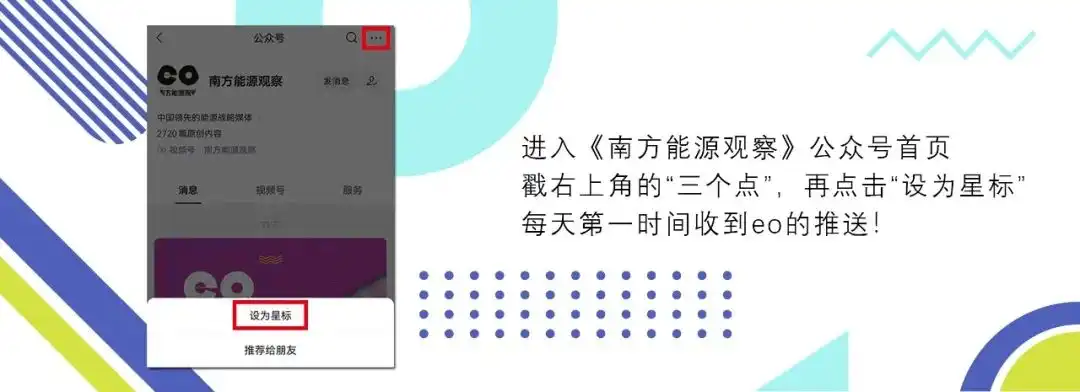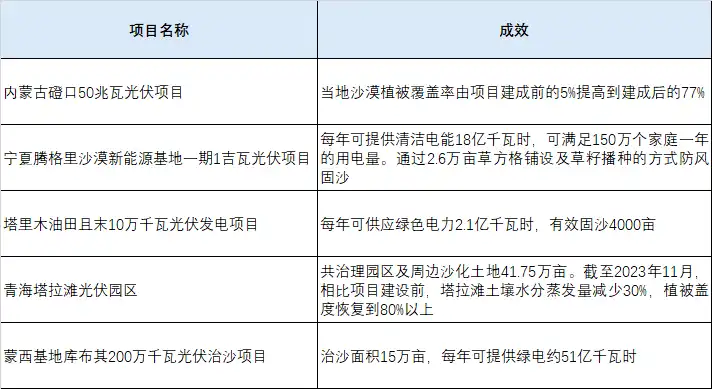Photovoltaic desertification control:A new business format that combines desert management and power generation
全文2322字,阅读大约需要4分钟
Reproduction in any form without permission is strictly prohibited

Southern Energy Watch
micro-signal:energyobserver
Welcome to submit, submit email:

Eo reporter Jiang Tao Compiled
Editor He Nuoshu
Review Jiang Li
China is one of the countries in the world with the largest desertification area, the largest affected population, and the most severely damaged by sandstorms. According to data released by Xinhua Agency, as of June 2023, 3.861 billion acres of desertified land across the country, affecting the production and life of more than 400 million people.
For a long time, China has regarded combating desertification as an important strategic task and adopted a series of effective measures. In recent years, photovoltaic desertification control, as a new business format, combines desertification control and power generation two seemingly unrelated industries, and has become an important choice for China's desertification control.
This article compiles the main methods of desertification prevention and control, the practices and effects of photovoltaic desertification control, etc., so as to facilitate readers to understand relevant concepts.
sand prevention and control
There are three types of traditional measures to prevent and control desertification:
The first category is biological desertification control, that is, desertification control by planting psammophytes. 沙生植物指的是生活在以沙粒为基质沙土生境的植物,根据植物对风沙基质的关系,可划分为抗风蚀沙埋、耐沙割、抗日灼、耐干旱、耐贫瘠等类型。常见的沙生植物有胡杨、花棒、骆驼刺、沙蒿、卷柏、沙枣等。然而由于沙漠地区干旱,往往造林多成林少,因此生物治沙的效果并不是很显著;
The second type is sand barriers and sand fixation. 沙障主要分为草方格沙障、黏土沙障、篱笆沙障、立式沙障、平铺沙障等不同的类型。草方格是最为常见的沙障,使用麦草、稻草、芦苇等材料,在埋入沙地后,沙障会在流动沙的丘上形成一层能够阻挡风的墙。这堵墙不仅能削弱风力的侵蚀,同时还能够在降雨时留住雨水,提高沙层里水的含量,草方格里栽种的沙生植物有了足够的水,就能更好的生长。虽然沙障的种类繁多,但沙障只能就地固沙,且障间积沙很容易饱和,治标不治本;
** The third category is defensive measures, that is, the delineation of closed areas for protection. ** Grazing, mining and other activities are prohibited in the enclosed area to promote the natural restoration of the ecological environment.
Photovoltaic desertification control
1. What is photovoltaic desertification control?
Photovoltaic desertification control refers to the construction of photovoltaic power stations in desert areas, combining photovoltaic power stations with desert management and water-saving agriculture, planting and building protective forest systems on the periphery of photovoltaic power stations, and installing water-saving drip irrigation facilities under photovoltaic panels.
2. Why should we carry out photovoltaic desertification control?
Photovoltaic desertification control has the following advantages:
**(1)** Desertification areas are generally sunny, and building photovoltaic power generation for desertification control has resource advantages;
(2) Photovoltaic power generation as a clean energy source can reduce the greenhouse effect of fossil energy and improve drought in sandy areas;
(3) Photovoltaic panels have wind and sand fixation and sunshade effects. They can not only slow down desertification and reduce investment in desertification control, but also conserve water, develop cash crops to help the poor, and help people in sandy areas to generate economic income.
**(4)** The improvement of ecology is also beneficial to photovoltaic power generation. The coverage of vegetation can reduce the rise of dust, reduce the blocking of photovoltaic modules by dust, and help increase the power generation capacity of photovoltaic power plants.
In recent years, with the expansion of construction scale and the improvement of technology, photovoltaics have become the power source with the fastest cost reduction among new energy sources. Looking around the world, China's photovoltaic costs are also in an advantageous position internationally.
According to Wang Yankui, secretary-general of the National Innovation Alliance for Desertification Control and Sand Industry in Arid Areas, after a photovoltaic array is completed, it can reduce the average north-south wind speed by 50% and reduce soil water evaporation by 30%. The vegetation coverage under the board of the photovoltaic industrial park can reach more than 80%, which is 40% higher than that outside the park.
3. What are the main methods for photovoltaic desertification control?
The main method of photovoltaic desertification control is to combine photovoltaic power stations with desert management and water-saving agriculture, plant and build protective forest systems around the photovoltaic power stations, install water-saving drip irrigation facilities under photovoltaic panels, and plant green cash crops.
the specific method is:
在光伏电站外围设置锁边防护林,作为Level 1 protection;
在光伏电站场区内主干道路两侧设置防护绿化带,在检修道路两侧种植沙生植物或灌木,作为secondary containment;
在光伏阵列下方及前后排光伏阵列间设置沙障并种植沙生植物或灌木,作为three-level protection。
Primary and secondary protection plays a role in reducing wind speed and blocking wind and sand; tertiary protection is used to prevent the expansion of desertified land and improve land quality. Sand barriers are set on the windward side of the two rows of columns of the photovoltaic brackets below the photovoltaic array. Sand shrubs and grass plants are mixed and sown in the sand barriers. Photovoltaic power stations are used to generate electricity to drive the irrigation system and monitoring system to provide water to crops and monitor soil moisture.
Effectiveness of photovoltaic desertification control
In recent years, China has promoted photovoltaic desertification control projects in deserts and desertified areas in Inner Mongolia, Ningxia, Xinjiang and other places, achieving the dual benefits of clean energy and ecological environment.
In 2017, at the 13th Conference of the Parties to the United Nations Convention to Combat Desertification, Kubuqi was written into the United Nations Declaration as China's successful practice of desertification prevention and control, becoming a global model for combating desertification. As of August 2023, the Kubuqi Desert in Inner Mongolia, with a total area of 18,600 square kilometers, has a controlled area of more than 6000 square kilometers, the vegetation coverage rate within the controlled area has reached more than 50%, and the number of animals and plants has increased from 100 species to 530 species.
The results of the sixth national desertification and desertification survey released at the end of 2022 show that China's desertification and desertified land area has maintained "double reduction" for four consecutive monitoring periods.
table:Information on some typical photovoltaic desertification control projects

